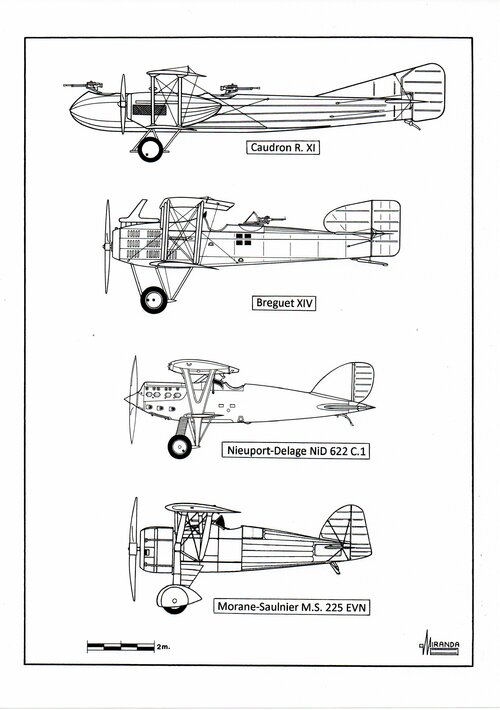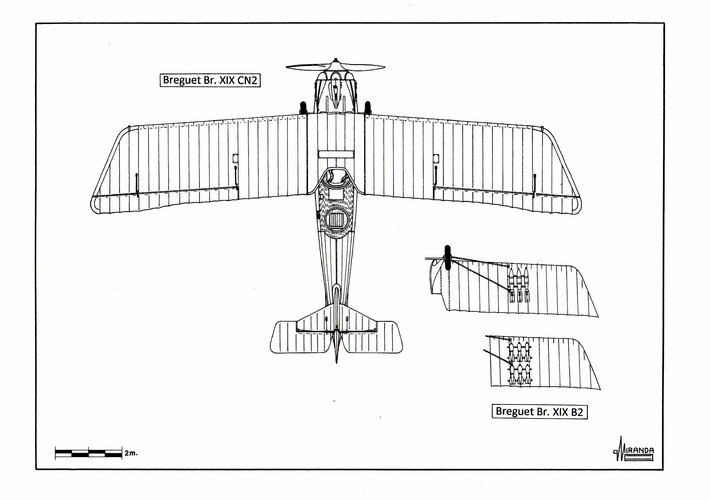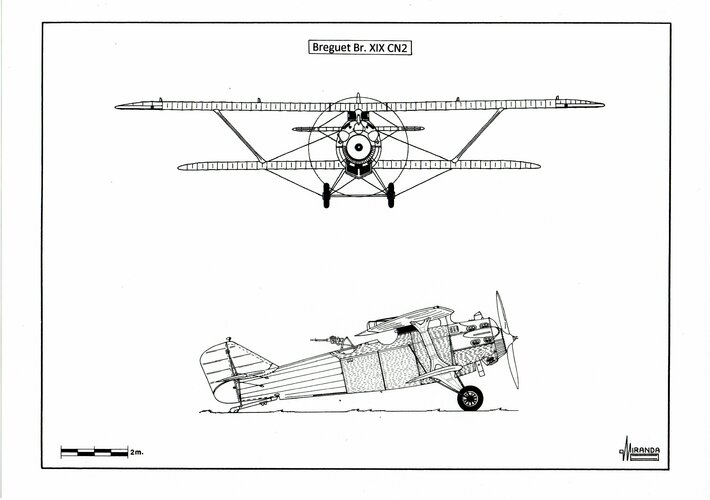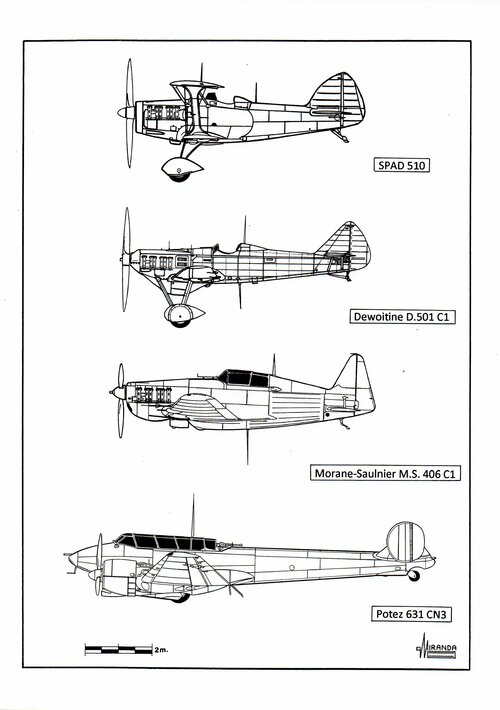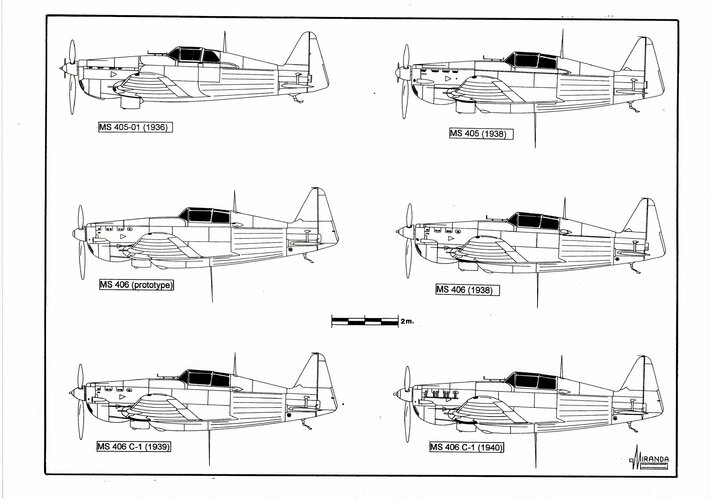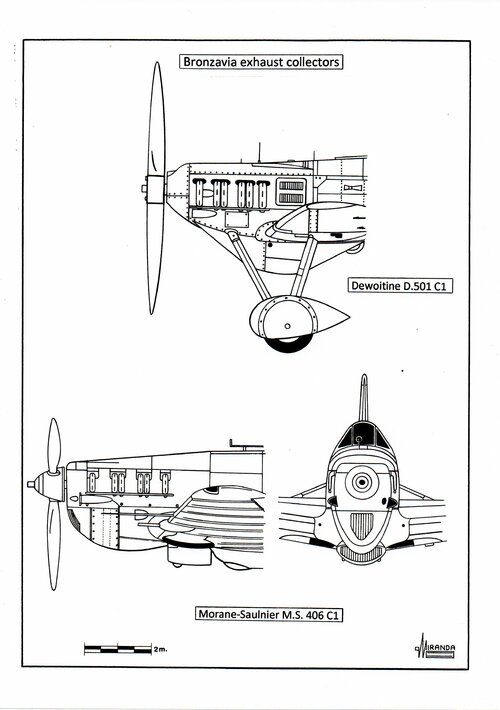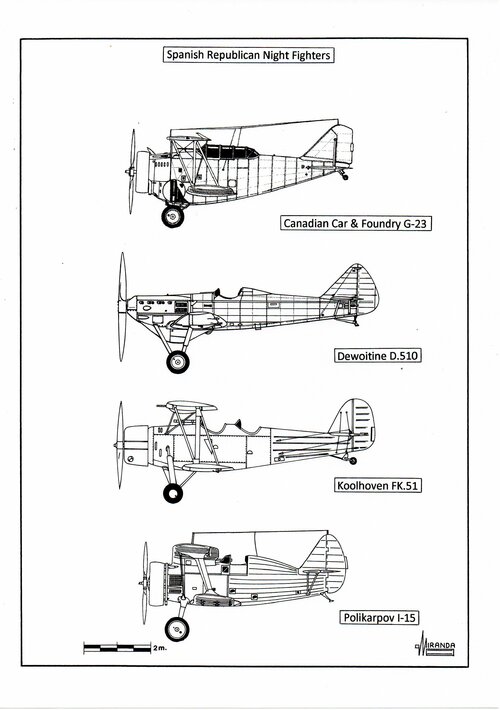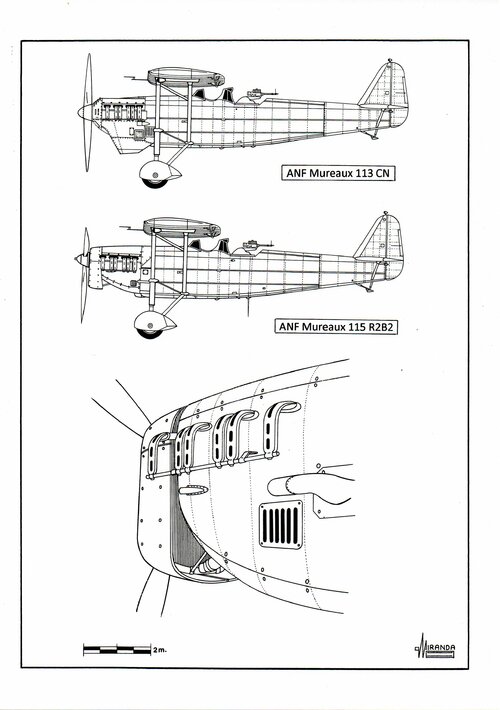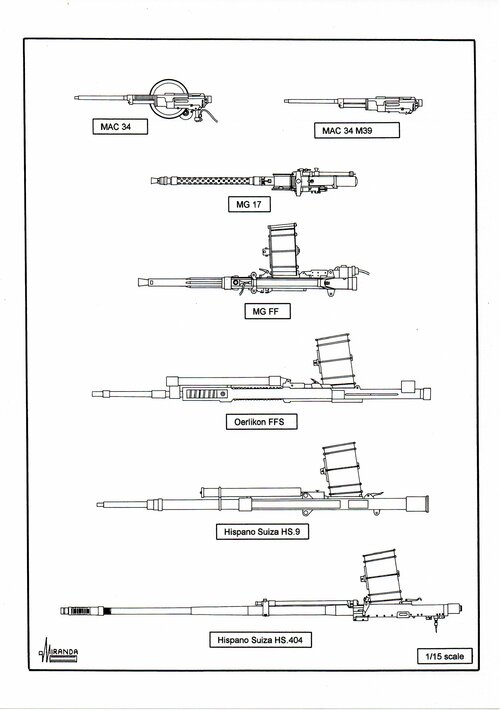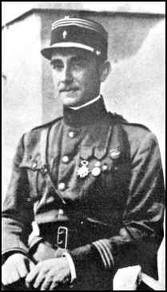French Night Fighters
Between February 1918 and July 1922 the French Aéronautique Militaire used the Caudron R.XI heavy escort fighters from the Escadrille C 46, in joint operations with the Breguet XIV night bombers of the 3ême regiment de bombardement.
In 1924 a night fighter unit was officially created using Breguet XIV B2 bombers converted into night fighters, fitted with flare launchers and Vérain landing lamps on the lower wings.
The two types of aircraft: CAP (Chasse, Reconnaissance d’Armée et Protection) and CAN (Chasse et Reconnaissance d’Armée de Nuit), were called combattants de nuit and were replaced in 1926 by the Breguet Br. XIX B2 night bombers from the 23ème escadrille du 12ème RAB-Reims.
In 1932, forty Br. XIX B2 bombers were converted into Br. XIX CN2 (Chasseur de Nuit- Biplace) night escort fighters armed with two nose mounted machine guns.
Between 1932 and 1934 these aircraft were used by the 22ème and 23ème Escadrilles de Chasse de Nuit from GB III/22-Chartres.
Caudron R. XI C.3 technical data
Wingspan: 58.8 ft. (17.92 m), length: 36.8 ft. (11.22 m), height: 9.84 ft. (3 m), wing area: 602.7 sq. ft. (54.25 sq. m.), max weight: 4,779 lb. (2,165 kg), max speed: 114 mph (183 km/h), service ceiling: 19,516 ft. (5,950 m.), range: 110 miles (177 km), power plant: two Hispano-Suiza 8Bda, eight cylinder, Vee, liquid cooled engines rated at 215 hp. each, armament: five 7.7-mm Lewis machine guns.
Paint scheme (1919): overall three shades of Brun Foncé (Dark Brown /Federal Standard Reference FS 30045), Terre de Sienne (Sienna FS 30219), Vert Foncé (Dark Green FS 30219) and four positions cocardes (French roundels).
Breguet XIV CN2 technical data
Wingspan: 47 ft. (14.36 m), length: 28.8 ft. (8.87 m), height: 10.8 ft. (3.3 m), wing area: 540 sq. ft. (50.2 sq. m.), max weight: 3,900 lb. (1,769 kg), max speed: 121 mph (195 km/h), service ceiling: 20,300 ft. (6,200 m), power plant: two Renault 12 Fcx, twelve cylinder, Vee, liquid cooled engines rated at 300 hp. each, armament: two nose mounted 7.7-mm Vickers 7.7-mm and two movable 7.7-mm Lewis machine guns.
Paint scheme (1919): overall three shades of Brun Foncé (Dark Brown FS 30045), Terre de Sienne (Sienna FS 30219), Vert Foncé (Dark Green FS 30219) and four positions cocardes.
Breguet XIX CN2 technical data
Wingspan: 48.6 ft. (14.83 m), length: 31,5 ft. (9.61 m), height: 12 ft. (3.69 m), wing area: 538 sq. ft. (48.42 sq. m.), max weight: 5,511 lb. (2,500 kg), max speed: 133 mph (214 km/h), service ceiling: 23,620 ft. (7,200 m), range 497 miles (800 km), power plant: one Lorraine-Dietrich 12 Hb, twelve cylinder, Vee, liquid cooled engine rated at 500 hp., armament: two nose mounted 7.7-mm Vickers 7.7-mm and two movable 7.7-mm Lewis machine guns.
Paint scheme: overall Vert-Kaki (Dark Green FS 34257), Couleur Aluminium (Natural Metal) engine cowling and four positions cocardes.
On May 10, 1934 the German Government officially recognized the existence of the Luftwaffe and the French Government reacted by creating l’Armée de l’Air as an organism independent and five Plans de Réarmement Aérien 1934-1940.
On October 31, the French Air Ministry issued a specification for the multiplace léger de defense Potez 63, designed to intercept the new German Dornier Do 23 (161 mph) bombers.
During the maneuvers of 1934, some Nieuport-Delage NiD 622 C.1 day fighters from GC II/4 failed in the night defense of Paris when their pilots were blinded by l’Armée de Terre searchlights.
Paint scheme: Vert-Kaki (Dark Green FS 34257) overall, Couleur Aluminium (Natural Metal) engine cowling and four positions cocardes.
Nieuport-Delage NiD 622 C.1 technical data
Wingspan: 39.4 ft. (12 m), length: 25 ft. (7.64 m), height: 9.8 ft. (3 m), wing area: 311.6 sq. ft. (28.95 sq. m.), max weight: 4,037 lb. (1,831 kg), max speed: 170 mph (270 km/h), range: 559 miles (900 km), service ceiling: 26,900 ft. (8,200 m), power plant: one Hispano-Suiza 12 Hb, twelve cylinder, Vee, liquid cooled engine rated at 500 hp., armament: two nose mounted 7.7-mm Vickers machine guns.
The combattants de nuit were organized into four types for air defense at night: single seaters, high-performance day/night fighters provided point defense over high-value targets, two seaters night fighters (ANF Mureaux 113 CN2) flew patrols between two airbases, two seaters nigh intruders (ANF Mureaux 115 R2B2) to attack enemy’s airfields and three seaters heavy fighters (Potez 63) to attack day/night German bombers.
In 1935 the Groupe de Chasse de Nuit GCN 1/42-Reims carried out night interception experiments using two Morane-Saulnier M.S. 225 EVN (Equipment de Vol de Nuit) night fighters.
These aircraft were powered by supercharged engines and had an exceptional rate of climb of 1,205 ft/min.
Paint scheme: Vert-Kaki (Dark Green FS 34257) overall, Couleur Aluminium (Natural Metal) engine cowling, landing gear and forward fuselage section, four positions cocardes.
Morane-Saulnier M.S. 225 EVN technical data
Wingspan: 34.6 ft. (10.56 m), length: 23.8 ft. (7.25 m), height: 10.7 ft. (3.26 m), wing area: 185 sq. ft. (17.2 sq. m.), max weight: 3,505 lb. (1,590 kg), max speed: 208 mph (334 km/h), range: 435 miles (700 km), service ceiling: 32,800 ft. (10,000 m), power plant: one Gnome-Rhône 9 Kdrs, nine cylinder, radial, air cooled engine rated at 500 hp., armament: two nose mounted 7.5-mm Vickers machine guns.
On October 15, 1936 was formed the 4ème Escadre de Chasse Mixte with four Escadrilles: EC 1/4 with Dewoitine D.510 day fighters, EC 2/4 with Dewoitine D. 500 day fighters, ECN 3/4 with ANF Mureaux 113 CN2 night fighters and ECN 4/4 with Dewoitine D. 501CN night fighters.
Dewoitine D.501CN technical data
Wingspan: 39.7 ft. (12.09 m), length: 24.8 ft. (7.56 m), height: 11.2 ft. (3.4 m), wing area: 183.3 sq. ft. (16.5 sq. m.), max weight: 3,951 lb. (1,790 kg), max speed: 223 mph (359 km/h), range: 535 miles (860 km), service ceiling: 26,200 ft. (8,000 m), power plant: one Hispano-Suiza 12 Xcrs, twelve cylinder, Vee, liquid cooled engine rated at 660 hp., armament: one engine mounted 20-mm Hispano HS9 cannon and two wing mounted 7.7-mm Darne machine guns.
Still in 1937, the best fighter in the world was French. The airplane, named Morane-Saulnier M.S.405, was a single-engine, single-seat, low wing monoplane with retractable undercarriage and closed cockpit.
Unfortunately for the democracies, during the year 1937 were revealed to the world the Heinkel He 111 V4 prototype (217 mph), the Dornier Do 17 V8 prototype (243 mph), the Messerschmitt Bf 109 B-1 (287 mph) and the Messerschmitt Bf 109 V13 prototype (380 mph).
The construction of one hand-made M.S. 405 required 300,000 hours, that of one mass-built M.S.406, 40,000 hours and that of one Messerschmitt Bf 109 B only 5,000 hours.
In October 1937 l’Armée de l’Air continued to experiment with night interception tactics using several Spad S.510 C.1 day fighters from the 7ème Escadre-Dijon, but during the tests he discovered that the pilots were dazzled by the glare generated by the engine exhausts.
After the annexation of Austria (Anschluss) on March 13, 1938 some Spads from GC I/7 and GC II/7 were modified as night fighters S.510 CN with the installation of Bronzavia exhaust collectors made of stainless steel, to aid night flying, Michelin flare bombs under the fuselage and Ducretet-Thompson Type 535 R/T devices.
Paint scheme: Vert-Kaki (Dark Green FS 34257) overall, Couleur Aluminium (Natural Metal) engine cowling, landing gear and fuselage sides, four positions cocardes.
Bleriot-Spad S.510 CN technical data
Wingspan: 29 ft. (8.84 m), length: 24.5 ft. (7.46 m), height: 12.2 ft. (3.72 m), wing area: 237 sq. ft. (22 sq. m.), max weight: 3,638 lb. (1,650 kg), max speed: 229 mph (370 km/h), range: 544 miles (875 km), service ceiling: 33,128 ft. (10,100 m), power plant: one Hispano-Suiza 12 Xbrs, twelve cylinder, Vee, liquid cooled engine rated at 690 hp., armament: four wing mounted 7.5-mm MAC 34 machine guns.
In May 1938, after the Anschluss, seven pre-production Morane-Saulnier M.S. 405 day fighters, replacing the Spads S.510 CN, were tested at the 2ème Escadrille d’Experimentation from GC 1/7 Reims.
The Plan C.1/1934 specification called for a high-performance day fighter with the possibility of night use.
The M.S. 405s were tested at night equipped with Bronzavia exhausts, Holt flares and bombes éclairantes Michelin.
Ground control interception experiments were also conducted using air-to-ground Ducretet type 535 R/T devices, with 60/80 Km range.
Paint scheme Système D: Vert-Kaki (Dark Green FS 34257) upper surfaces, Gris-Bleu Ciel (Skygrey Blue-FS 35352) undersurfaces, four positions cocardes.
Morane-Saulnier M.S. 405 technical data
Wingspan: 34.8 ft. (10.61 m), length: 26.7 ft. (8.13 m), height: 8.9 ft. (2.71 m), wing area: 190 sq. ft. (17.10 sq. m.), max weight: 5,375 lb. (2,435 kg), max speed: 302 mph (486 km/h), range: 622 miles (1,000 km), service ceiling: 29,520 ft. (9,000 m), power plant: one Hispano-Suiza 12 Ycrs, twelve cylinder, Vee, liquid cooled engine rated at 835 hp., armament: two wing mounted 7.5-mm MAC 34 machine guns.
The Morane-Saulnier production fighter M.S.406 C.1 of 1939 was armed with a 20-mm cannon (a secret weapon at that time) firing through the propeller hub, capable of shooting any German bombers in service. It also possessed enough speed and manoeuvrability to face the Jumo powered German fighters Bf 109 B-2 (465 km/h) and C-1 (467 km/h) using its MAC machine guns.
During the Phoney War (3 September 1939 to 10 May 1940) the M.S.406 made 10,119 combat missions destroying 81 German airplanes.
The appearance of the Bf 109 E-1 (547 km/h) over the French skies on September 21, 1939, amounted to a technological advantage that gave the aerial superiority to Germans at the critical moment of the Blitzkrieg offensive in May 1940.
The M.S. 406 received numerous modifications to continue fighting: The MAC 34A drum feed machine guns were replaced by the new belt feed model MAC 34 M39, the OPL 1931 gunsight was replaced by one GH-38, the windshield and the radiator were also modified, the Ratier 1607 propeller was standardized and the anti-glare Bronzavia exhausts were replaced by the new Bronzavia-Gal (with propellant effect) to save drag.
These modifications allowed the improved M.S. 410 version to reach a top speed of 316 mph (509 km/h).
Many M.S. 406s were used as point-defence interceptors in D.A.T. (Défense Aérienne du Territoire) missions, directed by radio against the incoming bombers.
Some aircraft used in anti-aufklärers dusk & dawn patrols, kept the anti-glare exhaust.
Paint scheme: upper surfaces in five shades of Gris-Bleu Foncé (Dark-Blue Grey-FS 36320), l’Ombre Calcinée (Light Blue-Grey FS 35352), Terre de Sienne (Sienna FS 30219), Brun Foncé/Chocolat (Dark Brown-FS 30045) and Vert Foncé (Dark Green- FS 34201), under surfaces in Gris-Bleu Ciel (Skygrey Blue-FS 35352). In January 1940 the use of fuselage cocardes with 80 cm in diameter became mandatory.
Morane-Saulnier M.S. 406 C.1 technical data
Wingspan: 34.8 ft. (10.61 m), length: 26.7 ft. (8.13 m), height: 8.9 ft. (2.71 m), wing area: 190 sq. ft. (17.10 sq. m.), max weight: 5,355 lb. (2,426 kg), max speed: 302 mph (486 km/h), range: 622 miles (1,000 km), service ceiling: 32,308 ft. (9,850 m), power plant: one Hispano-Suiza 12 Y31, twelve cylinder, Vee, liquid cooled engine rated at 835 hp., armament: one engine mounted 20-mm HS.404 cannon and two wing mounted 7.5-mm MAC 34 machine guns.
The Chasse Obscure (Dark Fighting) tactic adopted by l'Armèe de l'Air after the Munich Agreement, did not use searchlights to prevent the loss of night vision of the pilots.
The French divided the front into sectors 15 km (9.3 mi) wide and 20 km (12.4 mi) deep guarded by sound locators. When an intruder was detected, trained personnel tried to predict its possible trajectory and reported to the Control Center to direct night fighters in their interception, using the R/T and Direction Finder (D/F) systems.
In January 1939 l'Armèe de l'Air had two Groupes de Chasse de Nuit (Night Fighters Group) with two Escadrilles de Chasse de Nuit, the ECN III/1 based at Etampes and the ECN II/4 based at Reims, both escadrilles were equipped with night fighters ANF Mureaux 113 CN2 (170 mph-274 km/h) and Dewoitine D.501CN (228 mph-367 km/h).
Both types were fitted with 20 mm cannons, night instruments, OTC 31 R/T devices and overall Vert Foncé (Dark Green- FS34201) paint scheme with Couleur Aluminium (Natural metal) engine cowling and four positions cocardes. In April 1940 the aircraft received the same type of camouflage as the day fighters, with six positions cocardes.
The organization of the Chasse de Nuit, based on ideas and tactics developed during the First World War did not surpass the reality of the combats in 1940.
According to the theory, the pilots should approach the target up to 500 yards and identify it visually with the help of a small searchlight before firing.
In practice the maximum speed of the French night fighters proved insufficient to hunt down the new Bombers Heinkel He 111 P-2 (247 mph-397 km/h), Dornier Do 17 Z-3 (255 mph-410 km/h) and Dornier Do 215 B-0 (292 mph-470 km/h).
ANF Mureaux 113 CN2 technical data
Wingspan: 50.5 ft. (15.4 m), length: 32.7 ft. (9.98 m), height: 11.6 ft. (3.55 m), wing area: 376 sq. ft. (33.8 sq. m.), max weight: 5,649 lb. (2,558 kg), max speed: 170 mph (274 km/h), service ceiling: 32,800 ft. (10,000 m), range: 572 miles (920 km), power plant: one Hispano-Suiza 12 Ybrs, twelve cylinder, Vee, liquid cooled engine rated at 650 hp., armament: one engine mounted 20-mm HS 9 cannon, two nose mounted 7.5-mm MAC 34 machine guns and one flexible MAC 34 in the dorsal post.
ANF Mureaux 115 R2B2 technical data
Wingspan: 50.5 ft. (15.4 m), length: 32.7 ft. (9.98 m), height: 11.6 ft. (3.55 m), wing area: 376 sq. ft. (33.8 sq. m.), max weight: 6,369 lb. (2,885 kg), max speed: 199 mph (320 km/h), service ceiling: 32,800 ft. (10,000 m), range: 932 miles (1,500 km), power plant: one Hispano-Suiza 12 Ybrs, twelve cylinder, Vee, liquid cooled engine rated at 650 hp., armament: one engine mounted 20-mm HS 9 cannon, two nose mounted 7.5-mm MAC 34 machine guns and two flexible MAC 34s in the dorsal post.
In February 1939, Mureaux and Dewoitines began to be replaced by the Potez 630 type (286 mph-460 km/h) twin engine heavy fighter, but this model was prematurely withdrawn from service with the GCN I/13, due to engine problems, and was replaced in turn by the Potez 631 CN3 in August.
The new night fighter was somewhat slower (275 mph-442 km/h) but was very well armed with two 20 mm cannon and four 7.5 mm machine guns.
A few days after the declaration of war against Germany, some Potez 631 CN3 were concentrated at the Melun-Villaroche air base to perform night fighting simulations using different combinations of searchlights, sound locators and D/F devices.
The results of the new tactics were inconclusive and eventually the Chasse Obscure doctrine prevailed.
The day of the German attack (May 10, 1940) l'Armèe de l'Air had five Escadrilles de Chasse de Nuit, the ECN 1/13, ECN 2/13, ECN 3/13, ECN 4/13 and ECN 5/13 equipped with 58 Potez 631 CN3 of which only 47 were in flying condition.
His combat career was very brief, limiting himself to making 78 night sorties, between May 11 and 16, without achieving any kill, and l'Armèe de l'Air decided to use them in day time fighting and ground attacks to the Wehrmacht motorized columns in Fourmies and Moirans areas.
In their new role the Potez managed to destroy eight Heinkel He 111s and one Dornier Do 17, but suffered numerous attacks erroneously carried out by French and British fighters who mistook them for German Messerschmitt Bf 110s. Three Potez heavy fighters were shot down and three others badly damaged by friendly fire.
These aircraft used the same paint scheme as the French day fighters: upper surfaces in three shades of Gris-Bleu Foncé (Dark-Blue Grey-FS 36320), Brun Foncé (Dark Brown-FS 30045) and Vert Foncé (Dark Green- FS 34201), under surfaces in Gris-Bleu Ciel (Skygrey Blue-FS 35352).
Between January and February 18, 1940 the Potez 631 c/n 117 was painted with an experimental night camouflage scheme: upper surfaces in three shades of Gris-Bleu Foncé (Dark-Blue Grey-FS 36320), Noir (Black FS 37038) and Vert Foncé (Dark Green- FS 34201), under surfaces in Noir (Black FS 37038).
At the end of May l'Armèe de l'Air ordered that all Potez of the models 63.11, 631 and 637 Bons de Guerre (in flying condition) be identified with additional markings to avoid confusion with the Messerschmitt Bf 110.
The aircraft were painted with longitudinal white bands on the fuselage sides and to the 120 cm cocardes located on the upper surface of the wings were added two additional cocardes of only 30 cm diameter on the wingtips.
MAC 34 (7.5-mm)
Designed and built by Manufacture d’Armes in Chatellerault (MAC) during the year 1934, it was the standard machine gun used by the French fighters during the ‘Phoney War’ and the Battle of France. The commonest model was the MAC 34A (for Aile, the French word for wing), gas operated, electro pneumatically loaded, fed from a helical pan 'drum' magazine containing 300 rounds.
The MAC 34 was installed under the wings of the Morane-Saulnier M.S.406 and Potez 631 fighters in aerodynamic fairings with the drum magazine housed within the wing. The joining system was of the cardan type and could be regulated for convergence at an affective range of 250 m. The mechanism was very sensitive to cold temperatures and might occasionally cause a great firing dispersion.
The belt-feed MAC 34 M39 with 500-675 rounds was developed to solve this problem and reduce drag. It could be installed within the wing of the M.S. 410, Dewoitine D.520, Arsenal V.G. 33 and Bloch M.B.155 which all constituted the 2nd generation of French fighters of the war. There was a variant developed for the M.S.406 exportation version that could be integrated with the engine (firing through the propeller hub) and replaced the H.S.9 cannon. It was a version of the MAC 34A which was fed with a 500 rounds drum.
Another variant with flexible mounting, named MAC 34T (for tourelle, or turret in French) was used in bombers and multiplace fighters. The MAC 34 had a high rate of fire because of the short length of its barrel. Consequently, the muzzle velocity and destruction capacity were reduced up to a point of being considered an inefficient weapon against the He 111, Do 17 and Ju 88 bombers. The MAC 34 fired the short cartridge mod. 1929 with Armour Piercing (AP), Armour Piercing/Incendiary (API) and Armour Piercing Tracer (APT) ammunition. In the M.S. 406 and M.B. 152 the three types of ammunition were sequentially stored in the drums and belts, 40% of AP, 40% of API and 20% of APT.
In the Dewoitine D.520, two machine guns were loaded with AP and the other two with API (a hollowed AP that was then filled with phosphor). The incendiary power of the API was big and its penetration capacity almost non-existent. Additionally, its ballistic features differed from the AP type in the different weight between both bullets. The API was thermally unstable. The heating system of the D.520 weapons had to get disconnected after several cases of spontaneous ignition of the phosphor at temperatures between 40° and 45° C.
Oerlikon FFS (20-mm)
A small amount of these guns, together with their manufacturing license, was acquired by France in 1933. The FFS was not suitable for aircraft engine mounting because of the too advanced position of the recovery cylinder/yoke unit and had to be modified as Hispano-Suiza H.S.7. The French developed the SPAD S.XII in 1916 for the destruction of balloons. It was armed with a single-shot SAMC (APX) 37 mm cannon mounted between the V8 cylinder blocks of the 200 hp. Hispano-Suiza 8c engine.
The moteur-canon was not very successful, due to its slow reloading capacity and excessive recoil shock, and the SPAD S.XII was abandoned, but the French retained the idea until the arrival of the right time. This came in 1932 with the 690 hp. liquid-cooled engine Hispano-Suiza H.S.12 Xbrs of 12 cylinders in 60 degrees 'Vee' configuration.
This was the right engine to combine with one 20 mm Oerlikon FFS cannon (manufactured under license as Hispano-Suiza H.S.7) mounted between the two-cylinder banks. The crankcase was strengthened, and the reduction gear modified to bring the hollow propeller shaft in line with the gun barrel.
The ammunition was the same than that of the Swiss gun, contained in a 60 rounds drum. The H.S.7 was heavier, due to the fixation system to the engine, and had a rate of fire of just 350 rpm (compared to the 470 rpm of the Oerlikon) to protect the engine from any destructive vibration. This engine was then known as Hispano-Suiza 12 Xcrs (‘c’ for canon = cannon) and had reduced its power to 680 hp, consequence of the modifications made in the gearbox. The new moteur-canon was installed in the Dewoitine D.510 fighter and in the Loire-Nieuport L.N. 401/411 dive bombers of l’Aeronavale which fought the panzers on 15 May 1940.
The Germans tried to use the moteur-canon system with their Bf 109 V4, C-2 and E-2 fighters, trying different combinations of Jumo 210 and Daimler Benz 601 engines with MG 17 machine guns and MG FF cannons. But they found insoluble problems of cooling and crankcase destructive vibrations. On October 1940, they finally adapted an MG FF cannon behind the DB 601N engine of the Bf 109 F-0, but the device suffered structural damages during tests. The problem could not be solved until the MG 151/20 gun was available and could be installed in the Bf 109 F-2 in March 1941.
Hispano-Suiza H.S. 9 (20-mm)
In 1935 a 900 hp improved version of the H.S.12 Xcrs engine appeared, known as Hispano-Suiza H.S.12 Ycrs. The integrated cannon was also an improved version of the H.S.7 although somehow lighter and with 420 rounds per minute (rpm) rate of fire but maintaining the same muzzle velocity and destructive power than the Oerlikon. It fired the same type of HE, HET and AP ammunition than the Oerlikon, stored in a 60 rounds drum.
The HE type model 1936 was identified by a yellow band, the HET of 1939 with a yellow and blue band and the AP was overall painted in black. The HE had a 1937 model 17/19 B impact fuse and the HET also had a self-destruction system. The moteur-canon was very successful in the market, being acquired by the Czech Air Force to equip their Avia B-534, B-536 and B-135 fighters and by the Yugoslavian Air Force for their Ikarus Ik-2 and Rogozarski Ik-3. It was also used by l’Armèe de l’Air to power the Morane-Saulnier M.S.405.
Potez 631 CN3 technical data
Wingspan: 52.5 ft. (16 m), length: 36.3 ft. (11.07 m), height: 11.8 ft. (3.62 m), wing area: 363.3 sq. ft. (32.7 sq. m.), max weight: 6,181 lb. (2,800 kg), max speed: 275 mph (442 km/h), service ceiling: 31,000 ft. (9,451 m), range: 758 miles (1,220 km), power plant: two Gnôme-Rhône 14M 4/5 air cooled engines each rated at 700 hp., armament: two nose mounted HS 404 cannon, four wing mounted 7.5-mm MAC 34 machine guns and one flexible MAC 34 in the dorsal post.
Hispano-Suiza H.S. 404 (20-mm)
After the experience in combat against the fast and well armoured He 111 and Do 17 German bombers obtained during the Spanish Civil War, the engine designer Mark Birkigt decided to develop the H.S. 404 with higher performance. It was gas operated with a 166 per cent higher rate of fire and a muzzle velocity of 880 m/sec compared to the 820 m/sec of the H.S.9. The new weapon entered service in 1939 and could be installed either in the H.S.12 Y-31 engines of the M.S. 406 or in the H.S.12 Y-45 of the Dewoitine D.520, M.B. 155 and Arsenal VG 33 fighters.
The H.S. 404 fired 20x110 ammunition (that was not interchangeable with the 20x110 RB cartridges of the H.S .9) stored in a 60 rounds drum. There were six different types: HE model 1938 or 1939 (130 g) with a 17/19B 1938 model fuse identified by a yellow band, HET identified by a yellow and a blue-grey band, AP (165 g) black projectile with a red band, APT with black nose and metal-grey-metal-red bands, AP/HE with red-yellow-green bands and HEI with red-yellow-blue bands.
This type of ammunition had not been sufficiently tested and caused several accidents during combat. The Dewoitine D.520 fighters of the G.C.I/3 were specially affected, experiencing premature explosions within the barrel when firing the second burst. Between 5 and 8 June 1940 the M.S.406s of the G.C.I/6, G.C.II/2 and G.C.III/7 were used in ground attack task against the German tanks with AP and APT ammunition.
The manufacturing of the H.S. 404 was slow and costly. At the beginning of the war only 928 units had been delivered to l’Armée de l’Air and in March 1940 there were 2,319 units available.
The H.S. 404 was a formidable weapon when integrated in a Hispano-Suiza engine or installed in the nose of the twin engine Potez 631 fighters. However, it was less resilient when installed in the wings of the Bloch fighters, causing different problems of vibration, stoppage, freezing and dispersion of firing.
The H.S. 404 was acquired by the RAF and manufactured under license in the United Kingdom as Hispano-Suiza Mk I, Mk II and Mk V and as Hispano AN/M2 in the USA. A version over flexible mounting was also manufactured to be used by the rear gunners of the French medium bombers LeO 451 and Amiot 354.
In France, the Hurricanes and Gladiators of the British Expeditionary Force (B.E.F.) proved how difficult it was to shoot down a Heinkel He 111 with 270 kg armour and self-sealing fuel tanks in 1940. The British pilots often exhausted their 2,600 ammunition rounds without obtaining visible results while the Heinkel bombers often returned safely with up to 200 hits from rifle-calibre machine guns and were repaired in a few days.
The second generation of Hurricane and Spitfire designs were changed to incorporate twelve Browning guns, the combined fire resulted in 14,400 rounds every minute, but the total weight of rounds was only 360 lb. and four Hispano cannons, with explosive ammunition, produced 600 lb. per minute of destructive power.
These experiences influenced the design of the cannon armed Hurricane Mk. IIC and Spitfire Mk. V day fighters.
The British had acquired the manufacturing rights of the 20 mm Hispano-Suiza H.S. 404 cannon, with explosive shells, but its installation on the wings of fighters was problematic. The weapon had been designed as an integral part of the Hispano-Suiza H.S.12 Y-31 engine and lacked structural strength to act independently. The adaptation was difficult, during the Battle of Britain some Spitfires Mk. I of the 19th Sqn (WZ) experimentally equipped with two Hispano Mk. I, suffering numerous stoppage problems. The RAF avoided its usage until the appearing of the Mk. II in the summer of 1941.

